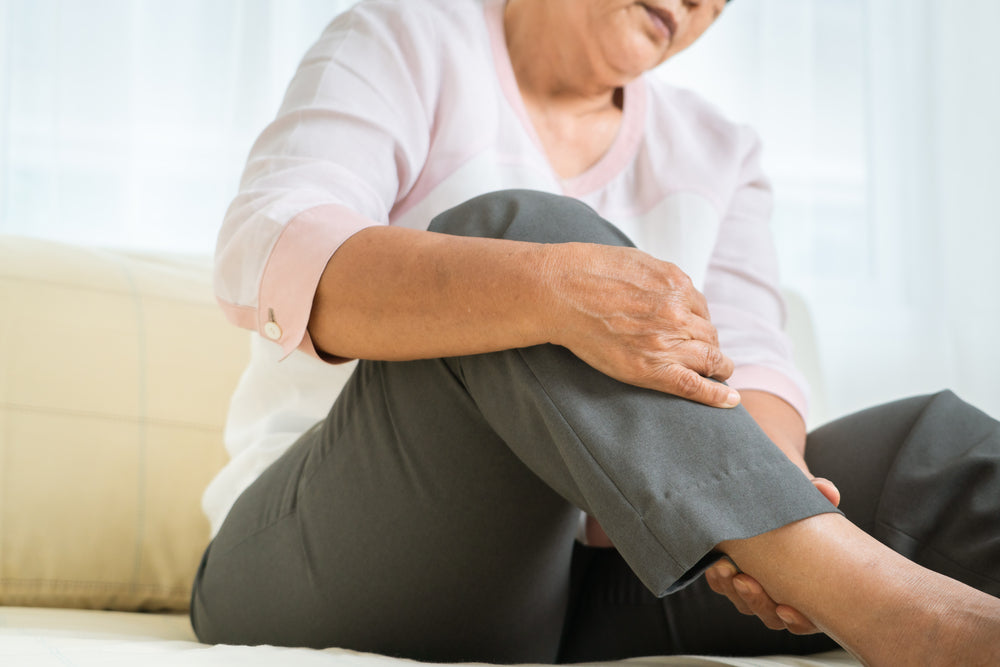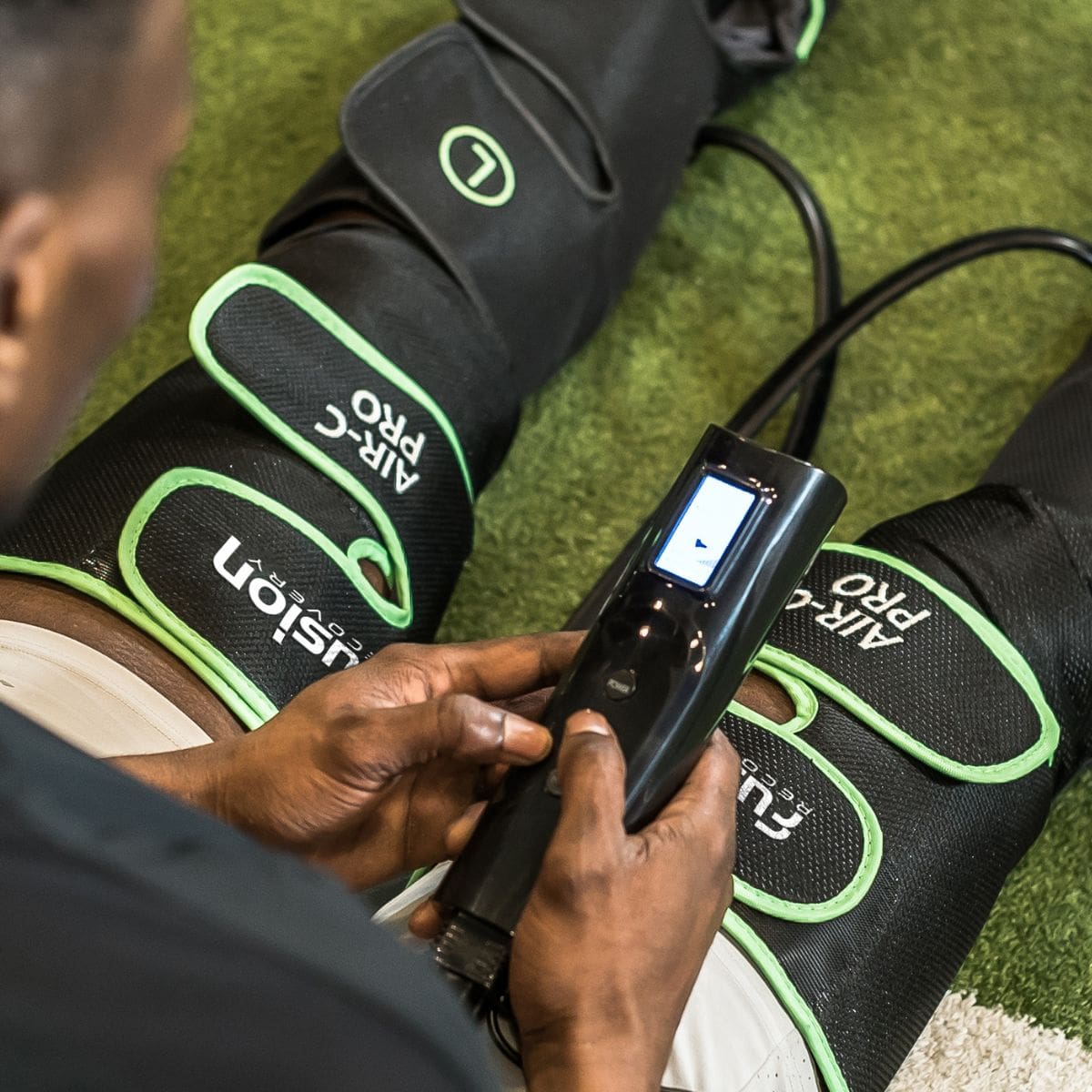Are you a caregiver in search of healthy ways to treat restless leg syndrome (RLS) in elderly patients?
Or maybe you're an elderly patient looking for ways to manage the symptoms of RLS yourself.
Either way, we're here to help you out.
Restless legs syndrome (RLS) is a neurologic movement disorder that affects the lower extremities of the human body.
Also called Willis-Ekbom disease, this health condition comes with an overwhelming urge to move the legs, leading to sleep disorders. For elderly patients, RLS can be especially problematic, as the quality of sleep is extremely important for their overall health.
It's usually diagnosed in people over the age of 50 and is estimated to affect over 10 percent of older adults.
While restless leg syndrome can be a difficult condition to manage for elderly individuals, there are a few steps that can be taken to help ease symptoms.
In this guide, we'll explore what steps seniors can take to treat restless leg syndrome. You'll also find out why it's important to recognize and treat RLS in elderly patients.
Preventive measures to take will also be discussed for those at risk of developing RLS. So, without further ado, let's get started.
5 Best Treatments for Restless Leg Syndrome in the Elderly
When it comes to finding relief from the symptoms of RLS, there are a number of options available for elderly patients.
Here are some of the most commonly recommended treatment options:
1. Stretching
While the thought of elderly patients engaging in physical exercise may seem daunting, stretching can be a great way to ease symptoms of RLS.
Simple stretches such as leg swings, heel-to-toe walking, or calf raises can help improve circulation and relieve tension in the legs. Many seniors also find that taking part in light stretching exercises can help reduce restlessness in the legs.
For best results, restless leg syndrome patients should aim to do stretches on a daily basis. Muscle groups like the calves, thighs, and hamstrings should be targeted specifically, as these are areas that are often affected by RLS.
2. Massage therapy

Getting a massage is a great way for elderly patients to take pressure off their legs and alleviate nighttime and daytime symptoms of RLS.
It can also be quite relaxing and help them get a better night's sleep. Massage therapy helps to reduce muscle tension and improve circulation, which helps reduce the overwhelming urge to move the legs.
It also releases endorphins, which act as natural painkillers and reduce stress levels.
Other benefits of effective therapy for elderly people include relief from muscle pain, improved flexibility, and increased joint mobility.
A leg massage can be done by a licensed massage therapist or through the use of a tool.
Leg massagers are a particularly great option for elderly patients, as they can be used in the comfort of their own home. Chic models like the Fusion Air C Pro feature a line of intensity settings that give you the control to customize your massage routine.
3. Heat or cold therapy
Next on our list of treatment options for restless leg syndrome in elderly patients is the application of heat or cold.
Heat helps to relax tense muscles, while cold helps to reduce inflammation and soreness. Therefore, applying either heat or cold to the legs can be an effective way of relieving RLS symptoms.
For heat therapy, a heated blanket, heating pads, or hot water bottle can be used, while cold therapy can be done with a cold pack or ice wrapped in a cloth.
As seniors tend to be more sensitive to changes in temperature, caution should be taken when applying either heat or cold. Heat should not be used for more than 20 minutes at a time, and cold should not be applied directly to the skin.
This way, elderly patients can effectively manage their RLS and get the restful sleep they need.
4. Relaxation techniques like yoga
Relaxation techniques such as yoga can be a great way for elderly people to find relief from restless leg syndrome.
Yoga helps to improve circulation, reduce muscle tension, and improve flexibility. It also promotes relaxation and has been known to lower stress levels.
Various poses like the seated forward fold, cat-cow pose, and cobra pose are gentle enough for seniors to practice while still providing them with the health benefits of yoga.
Other relaxation techniques proven to reduce RLS symptoms include breathing exercises, guided meditation, and progressive muscle relaxation.
5. Supplements or prescription medications
While any of the treatment options listed above can help manage RLS, supplements or medications may be necessary for elderly patients with severe symptoms.
For instance, iron supplements are often prescribed to restless legs syndrome patients with an iron deficiency as they can help reduce symptoms. Vitamin E and magnesium are also commonly used to ease restless leg syndrome in older adults.
Other medications that can be prescribed include dopamine agonists, gabapentin, and benzodiazepines.
Dopamine receptor agonists help to reduce any strong urge to move your legs by boosting dopamine levels, while gabapentin and benzodiazepines are primarily used for pain relief.
However, it is important to note that these medications can have severe side effects, so they should only be taken when necessary.
Whether you're an elderly patient looking for relief from restless leg syndrome or a caregiver looking to provide your loved ones with the best possible treatment, these are the most effective ways to manage RLS in older adults.
Next, we'll explore why these treatments are so important and how they can be used to ensure a better quality of life for elderly patients.
Importance of Treating Restless Leg Syndrome in the Elderly
As one of the most common medical conditions affecting seniors, restless leg syndrome (RLS) can cause a variety of problems that make day-to-day activities difficult.
That's why finding relief from this lifelong condition is so essential. But just why is treating RLS disorders in patients so important?
Here are a few reasons why:
Improved sleep quality
If you've ever experienced restless leg syndrome, you can attest to its ability to disrupt your sleep.
This occurs because RLS causes an uncomfortable sensation in the legs that forces you to move them in order to find relief. This, of course, can make it difficult to rest.
We all know how a lack of sleep can negatively affect our health and well-being. It can lead to an increased risk of depression, cognitive decline, high blood pressure, and a weakened immune system.
By using any of the long-term treatment options we've outlined, elderly patients can get the restful sleep they need and improve their overall quality of life.
Reduced risk of falls
A second reason why treating RLS in elderly patients is important is that it can help reduce the risk of falls.
Given that RLS causes an irresistible urge to move their legs, seniors can be more prone to tripping and falling when walking or standing. This is especially concerning for seniors, who are already at increased risk due to age-related factors such as poor balance and weakened muscles.
Fortunately, finding relief from RLS can help reduce instances of falls due to this condition.
With treatment options like massage therapy, seniors can remain more alert and less likely to stumble and fall.
Less pain and discomfort

Next on our list of benefits of treating RLS in elderly patients is less pain and discomfort.
As mentioned, the uncomfortable sensations associated with RLS can make it difficult to get a good night's sleep or engage in daily activities. And if left untreated, the duration of symptoms can worsen over time, resulting in increased pain and discomfort.
Thankfully, there are a variety of treatments available that can help reduce the pain and discomfort associated with RLS.
Take using a leg massager like the Fusion Air C Pro, for instance.
This powerful massage tool features air chambers that release air in rhythmic pulses for a deep and powerful massage. With regular use, elderly patients can experience relief from the painful symptoms of RLS and find comfort in their day-to-day activities.
Improved quality of life
Who wouldn't want to live a happier, healthier life?
Treating RLS in elderly patients can help them do just that.
By managing the symptoms of restless leg syndrome, seniors can live their lives more comfortably and with greater ease. This can result in an improved quality of life as they are able to engage in activities they once enjoyed without having an overwhelming urge to move their legs.
Plus, with improved sleep quality and less pain, seniors can also benefit from a boost in their overall energy levels. This makes it easier to stay active and engaged in life.
So there you have it—four reasons why treating RLS in elderly patients is so important. With the right treatment plan, seniors can find relief from the uncomfortable symptoms of restless leg syndrome and live a happier, healthier life.
But what if there was a way to avoid RLS altogether? Yes, you read that correctly.
By following a few simple lifestyle changes, you can reduce your risk of developing RLS and ensure that it doesn't become a problem in the first place.
Let's explore a few of them in the next section.
Tips to Reduce Risk of Restless Leg Syndrome in the Elderly
While finding relief from RLS is important for seniors, it's also beneficial to take preventative measures to ensure that you don't develop this condition in the first place.
Here are some tips to stay RLS-free:
Limiting caffeine and alcohol consumption
Limiting caffeine and alcohol consumption can help reduce the risk of developing restless leg syndrome in seniors.
Caffeine is a stimulant that can keep your body in “fight or flight” mode, while alcohol is a depressant that can disrupt regular sleep patterns. Both of these substances can contribute to restlessness during sleep.
By limiting their consumption, seniors can maintain regular sleep cycles and reduce their chances of developing RLS.
Staying away from smoking
Do you fall into the category of elderly smokers? Well, it’s time to kick the habit for good!
Research shows that smoking may increase your risk of developing restless leg syndrome. This is because smoking can cause changes in nerve activity, which can lead to increased feelings of restlessness in the legs.
So, if you’re an elderly smoker, take this as a sign to quit and reduce that overwhelming urge you have to move your legs.
Consuming iron-rich foods
Do you know that iron deficiency is one of the primary causes of restless leg syndrome?
It’s true!
Iron plays an important role in proper brain nerve function, and when levels are low, it can cause feelings of restlessness. Eating iron-rich foods like spinach, lentils, eggs, and beef liver can help keep your iron levels up and reduce any risk of iron deficiency anemia, a condition that can lead to restless leg syndrome.
Other great sources of iron include dark, leafy greens like kale and Swiss chard. Oral iron supplements can also be taken in addition to food sources.
For best results, seniors can also run blood tests to ensure they are not at risk of iron deficiency anemia.
Managing underlying medical conditions
Managing underlying medical conditions is another great way to reduce the risk of developing restless leg syndrome in seniors.
Common conditions – such as chronic kidney disease, diabetes, lung disease, and Parkinson's disease – can increase the chances of RLS symptoms. Therefore, it’s important for seniors to stay on top of managing any underlying conditions or chronic diseases they may have.
This includes receiving regular check-ups, taking counter drugs as prescribed, and following any suggested lifestyle changes from their healthcare provider.
Getting adequate restful sleep
When it comes to avoiding restless leg syndrome, getting adequate, restful sleep is essential.
Sleep deprivation can cause changes in nerve activity and increase the chances of developing RLS. To ensure good quality sleep, seniors should follow good sleep hygiene habits such as winding down before bedtime and avoiding caffeine or alcohol close to bedtime.
They should also try to get between 7 and 8 hours of sleep each night.
Frequently Asked Questions
Find answers to some of the most common questions we receive about restless leg syndrome in the elderly.
Whether you're an elderly person looking for ways to manage RLS or a caregiver for someone with the condition, you'll find helpful information here.
How is restless leg syndrome diagnosed for older people?
Restless leg syndrome can be difficult to diagnose in the elderly, as its symptoms may be mistaken for other chronic conditions.
However, it is important to get a proper diagnosis if you or a loved one are experiencing any of the symptoms associated with RLS.
To diagnose restless leg syndrome in seniors, a medical professional will first take a detailed medical history and physical exam. This will include questions about the patient’s diet, lifestyle, and any other medical conditions they may have.
A doctor may also order blood tests to check for any underlying nutritional deficiencies that could be contributing to RLS.
What are the potential causes of restless leg syndrome in older individuals?
The potential causes of restless leg syndrome in elderly individuals are not completely understood.
However, some potential causes include iron deficiency, anemia, and kidney disease. What's more, certain medications, such as antidepressants, antipsychotics, and antihistamines, have been linked to RLS in the elderly.
Other conditions that can increase the risk of RLS include diabetes, arthritis, Parkinson’s disease, and thyroid disorders, as we've mentioned above.
Can I use more than one treatment option for restless leg syndrome as an elderly person?
Yes, you can use more than one treatment option for restless leg syndrome in the elderly.
For instance, you can combine massage therapy, stretching exercises, and lifestyle changes to help manage your symptoms.
Additionally, medications such as dopaminergic drugs can be used in combination with other first-line treatments for more effective symptom relief. While medications can be helpful, it's important to talk to your doctor about the risks and benefits before you begin taking any new medication.
How long will it take for an elderly individual to find relief from restless leg syndrome?
The amount of time it takes for an elderly individual to find relief from restless leg syndrome will depend on several factors.
For example, how severe the condition is, how quickly treatment begins, and the type of treatment used.
Generally, it can take several weeks or even months before an elderly person finds relief from their symptoms. It’s important to be patient and consistent with treatment plans in order to achieve the best possible outcome.
This will ensure that you or your loved one can begin to live a more comfortable life.
Conclusion
With a wide range of adverse effects, restless leg syndrome can be a troubling condition for elderly individuals.
However, with the right treatment measures, seniors can reduce their risk of developing this medical condition and live more comfortably.
Treatment options particularly found to be effective in relieving RLS symptoms in patients include stretching, undergoing massage therapy, and taking over-the-counter medications, among others. Whichever treatment option you choose, it’s important to remain patient and consistent with it in order to achieve the best possible outcome.
Benefits that come from managing restless leg syndrome in seniors include improved quality of life, better sleep, and a reduced risk of falls.
While finding relief from RLS may take some time, the relief is worth it.
Preventive measures can also be taken to reduce the chances of developing this condition.
These include avoiding caffeine and alcohol, eating iron-rich foods, managing any underlying medical conditions, and getting adequate restful sleep. By following these tips, elderly individuals can live a more comfortable life and enjoy their golden years.
Hope this article has been helpful in understanding restless leg syndrome in the elderly. Let us know if you have any further questions that were not addressed.





